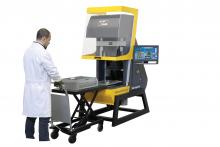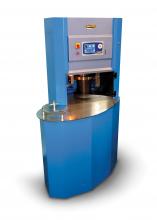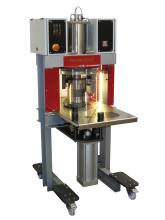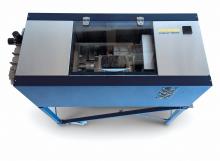This month we learn about a new test which is helping to predict the performance of asphalt mixtures containing recycled materials and modifiers, and we showcase some of the new testing equipment recently launched - writes Kristina Smith
Researchers in the US have come up with a new test to help owners and contractors better predict the performance of their roads. “The problem is that the current tests cannot determine the performance of new materials,” said Dr Haleh Azari, manager of the AASHTO Advanced P
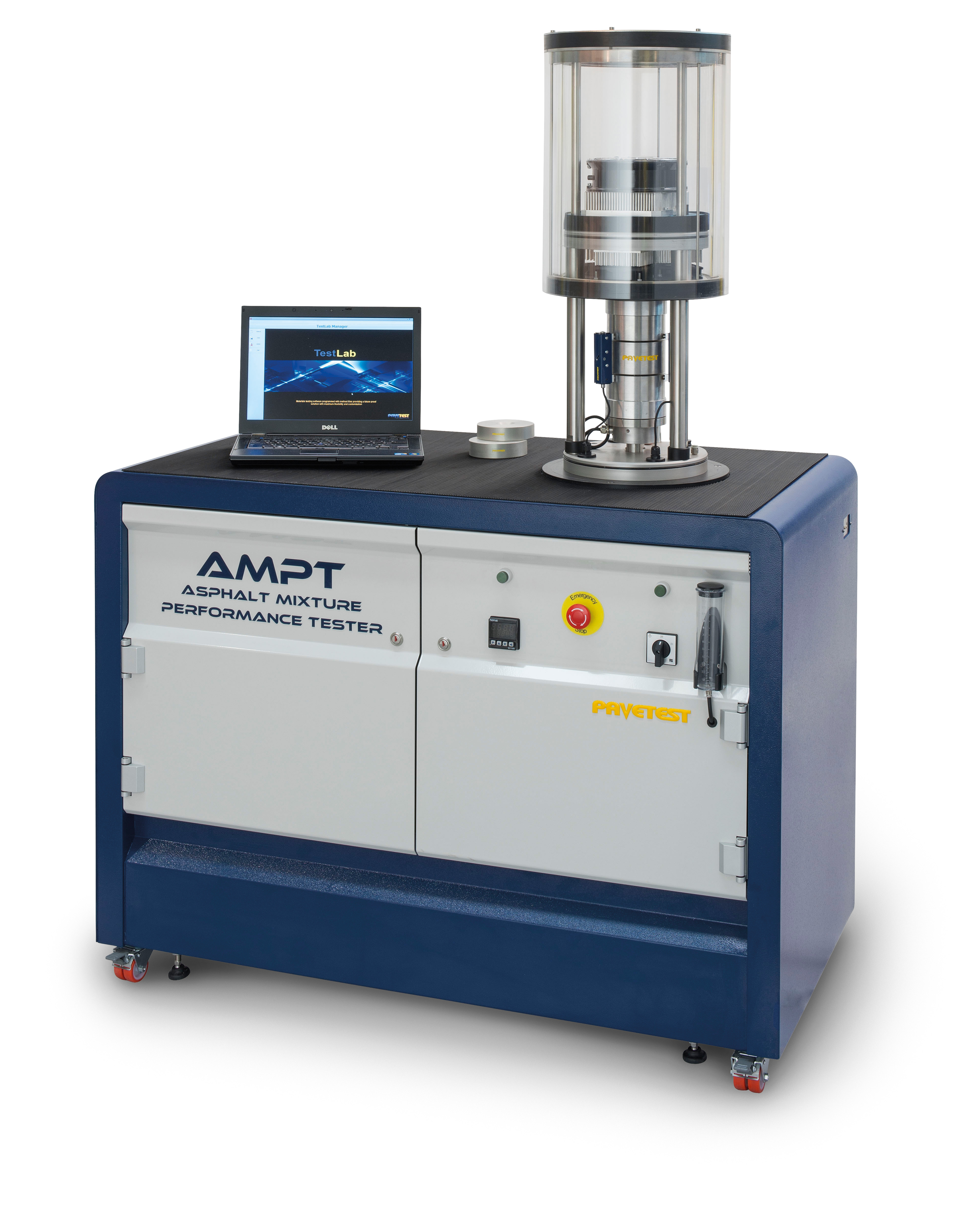
Pavetest says its version of the Asphalt Mixture Performance Tester is a next generation machine
This month we learn about a new test which is helping to predict the performance of asphalt mixtures containing recycled materials and modifiers, and we showcase some of the new testing equipment recently launched - writes Kristina Smith.
Researchers in the US have come up with a new test to help owners and contractors better predict the performance of their roads. “The problem is that the current tests cannot determine the performance of new materials,” said Dr Haleh Azari, manager of the AASHTO Advanced Pavement Research Laboratory (AAPRL) at the National Institute of Standards and Technology (NIST). These new materials include mixtures containing reclaimed Asphalt pavement (RAP) and reclaimed Asphalt shingles (RAS), warm mixes and asphalt containing ground tyre rubber and recycled engine oil and fuel.
“In the US they are seeing less and less rutting on the roads because they are adding more and more RAP,” said Azari. “On the other hand, roads are failing with fatigue cracking and very early ageing. They try to counter that by adding rejuvenators, but there is often a high variability in the mix leading to spots where the road fails.”
In States including Utah and Illinois, the Hamburg Wheel Tracker tests were showing that mixtures with RAP were meeting performance criteria, but in practice they were failing. “They were expecting 20 years but after five years, the roads were falling apart due to problems with fatigue,” said Azari.
In Florida, the opposite problem was occurring. Tests on polymer modified bitumen (PMB) using the flow number test showed the mixture would fail early due to rutting, but in the field these roads were resistant to rutting.
“The existing tests show that the bitumen grade is the same as before but in reality with the addition of modifiers the performance is changed significantly,” said Azari. “That is why there is the need for tests that reliably determine how the new materials will perform in the field. Our new test does determine the change in performance. It is very sensitive to the property of the material.”
Azari and Dr Alaeddin Mohseni, president of Pavement Systems, have developed the incremental repeated load permanent deformation (iRLPD) tests. These are a series of unified performance tests that, based on the same methodology, can be used on asphalt mixes, bitumen and on the ‘mastic’ extracted from an asphalt mix. They have also developed a modified version of the tests for bitumen emulsions.
There are 10 versions of the iRLPD test, designed to determine a range of performance characteristics of bitumen materials. The iRLPD test for rutting is to become a provisional AASHTO standard with the researchers planning to progress the other tests in the same direction.
Unlike existing tests which can take hours or days, the tests can be conducted in less than half an hour using the same specimen at different stress levels or temperatures. In the laboratory they can be done with existing equipment: for the mixtures, any dynamic triaxial loading machine which can be temperature controlled, perhaps by putting it in an environmental chamber; for the bitumen and mastic, a regular dynamic shear rheometer (DSR).
Azari and Dr Mohseni are also talking to manufacturers in the US and Europe about developing simpler machines which can be used out in the field for fast quality control. “These tests could be really useful to use alongside existing test methods,” said Dr Mohseni. “Because you can test the end product – what the bitumen becomes once it is put into the mix – you can determine the difference in performance of different mastics. And contractors will be able to use it to optimise the mix design.”
The researchers have spoken to road authorities in several European countries and will be speaking at conferences around the world, including Qatar and Italy. They are looking for laboratories in other countries who want to participate in a cooperative research study, comparing results in the lab and the field.
“The goal is working towards the full development and implementation of the new test methods,” said Azari. The researchers have devised a two-year plan to characterise mixtures from various regions of the world, to provide on-site demonstrations and training, and to conduct round robin testing of a standard material to ensure agencies are skilled to perform the tests and to prepare the tests to AASHTO and or ISO test methods. “After that, the next step is introducing it into pavement design,” said Azari. Cracks in asphalt roads can occur due to fatigue and early ageing and cause major problems
2139 CONTROLS PAVELAB SYSTEMS is now offering three versions of the Hamburg Wheel Tracker: one to test to European standards, one for US standards, and a third version aimed at developing markets which comes without the sliding safety covers, at a more competitive price.
Wheel trackers measure rutting and moisture damage of asphalt paving mixtures by rolling a wheel across the surface of a specimen. The European standard EN 12697- 22 requires a rubber wheel with tests carried out in the dry or in the wet; the AASHTO T324 standard calls for steel wheels tested in the wet. Controls’ Hamburg Wheel Tester can test two specimens of different dimensions simultaneously, although it cannot be used with a rubber wheel on one side and a steel one on the other. All three models benefit from the same Windows software.
“The operator can set the target temperature for the test, set the maximum depth the rutting must reach or the number of passes and then leave the machine to do the tests,” explained Controls engineer Matteo Dal Ben. “You could leave it overnight, come back in the morning and export all the data in order to produce the report for the client.”
The standard wheel load for all models is 705N, with heavier weight models available on request. Speed is adjustable from 20-30 cycles/minute and each wheel is fitted with rut depth transducers to measure ruts from 0-25 mm deep, plus or minus 0.01mm. Water temperature can be varied from 25-70°C, plus or minus 1°C, as required by the standards. The European and US versions of the wheel tracker were launched in late 2013 with the cover-free version released in May this year. “We have sold a lot of these machines,” said dal Ben. “And we are still getting a lot of enquiries, particularly from North and South America.”
2884 Humboldt manufacturing has launched a new crack monitoring device for long-term monitoring of concrete structures such as bridges and retaining walls. With integrated data logging to record displacement and ambient temperature, the monitors have been designed for ease of use and minimised visual impact.
“We get a lot of demand for crack monitoring equipment so this new product is quite exciting for us,” said John Lamond, general manager, sales and marketing for Humboldt. The ability to measure temperature is important for those studying the effects of temperature variation on a crack or element, added Lamond.
There are two versions of crack monitor: the HC-2955 and the HC-2956. The former allows data to be downloaded to a PC using a mini USB cable. The latter downloads wirelessly at a distance of up to 150m. They are configured using a graphic user interface which runs on Windows.
With an internal battery which lasts up to five years, the crack monitors can be installed in areas which are difficult to access, saving the time and cost of repeated visits to use manual devices. There are health and safety benefits too said Lamond, “The Bluetooth option means that the engineer can simply get to within 150m of the device and download the data. So there’s no need for lifting devices, scaffolding or difficult access challenges.”
The device measures cracks and linear displacements using a rotary, precision potentiometer which is driven by winding and unwinding a stainless steel wire which can measure a displacement of up to 80mm at a resolution of 0.003mm. It is also possible to add an extension to the steel cable to monitor cracks over wide expanses or areas that are not readily accessible, such as bridge decks, multifaceted structures and other hard-to-reach places. The frequency of readings for the USB crack monitoring device is adjustable between 10 seconds and 91 hours. For the Bluetooth version, this is adjustable between 1 minute and 92 hours.
7955 Pavetest, a new division of 282 Matest based in Australia, has developed its own version of the Asphalt Mixture Performance Tester (AMPT). Run by CEO Con Sinadinos and technical director Alan Feeley, both formerly of IPC Global, Pavetest aims to combine Australian design with Italian manufacturing.
The original AMPT was introduced in 2001. Pavetest’s version, developed by Sinadinos and Feeley in 2013, is “the next generation” of AMPTs, it says, with a number of developments to improve reliability, usability and environmental performance.
Notable features flagged up by the manufacturer include the built-in air compressor. “This eliminates the risk posed by moisture and contamination from often sub-standard air supplies and makes the unit truly ‘standalone’,” says Pavetest.
Another development from original versions is the hydraulic power supply which is based on inverter technology. This means that the speed of the hydraulic pump is reduced when maximum oil flow is not required, which is most of the time. “Operating the pump at slower speeds reduces noise, power consumption and heat generated,” said Pavetest.
Researchers in the US have come up with a new test to help owners and contractors better predict the performance of their roads. “The problem is that the current tests cannot determine the performance of new materials,” said Dr Haleh Azari, manager of the AASHTO Advanced Pavement Research Laboratory (AAPRL) at the National Institute of Standards and Technology (NIST). These new materials include mixtures containing reclaimed Asphalt pavement (RAP) and reclaimed Asphalt shingles (RAS), warm mixes and asphalt containing ground tyre rubber and recycled engine oil and fuel.
“In the US they are seeing less and less rutting on the roads because they are adding more and more RAP,” said Azari. “On the other hand, roads are failing with fatigue cracking and very early ageing. They try to counter that by adding rejuvenators, but there is often a high variability in the mix leading to spots where the road fails.”
In States including Utah and Illinois, the Hamburg Wheel Tracker tests were showing that mixtures with RAP were meeting performance criteria, but in practice they were failing. “They were expecting 20 years but after five years, the roads were falling apart due to problems with fatigue,” said Azari.
In Florida, the opposite problem was occurring. Tests on polymer modified bitumen (PMB) using the flow number test showed the mixture would fail early due to rutting, but in the field these roads were resistant to rutting.
“The existing tests show that the bitumen grade is the same as before but in reality with the addition of modifiers the performance is changed significantly,” said Azari. “That is why there is the need for tests that reliably determine how the new materials will perform in the field. Our new test does determine the change in performance. It is very sensitive to the property of the material.”
Azari and Dr Alaeddin Mohseni, president of Pavement Systems, have developed the incremental repeated load permanent deformation (iRLPD) tests. These are a series of unified performance tests that, based on the same methodology, can be used on asphalt mixes, bitumen and on the ‘mastic’ extracted from an asphalt mix. They have also developed a modified version of the tests for bitumen emulsions.
There are 10 versions of the iRLPD test, designed to determine a range of performance characteristics of bitumen materials. The iRLPD test for rutting is to become a provisional AASHTO standard with the researchers planning to progress the other tests in the same direction.
Unlike existing tests which can take hours or days, the tests can be conducted in less than half an hour using the same specimen at different stress levels or temperatures. In the laboratory they can be done with existing equipment: for the mixtures, any dynamic triaxial loading machine which can be temperature controlled, perhaps by putting it in an environmental chamber; for the bitumen and mastic, a regular dynamic shear rheometer (DSR).
Azari and Dr Mohseni are also talking to manufacturers in the US and Europe about developing simpler machines which can be used out in the field for fast quality control. “These tests could be really useful to use alongside existing test methods,” said Dr Mohseni. “Because you can test the end product – what the bitumen becomes once it is put into the mix – you can determine the difference in performance of different mastics. And contractors will be able to use it to optimise the mix design.”
The researchers have spoken to road authorities in several European countries and will be speaking at conferences around the world, including Qatar and Italy. They are looking for laboratories in other countries who want to participate in a cooperative research study, comparing results in the lab and the field.
“The goal is working towards the full development and implementation of the new test methods,” said Azari. The researchers have devised a two-year plan to characterise mixtures from various regions of the world, to provide on-site demonstrations and training, and to conduct round robin testing of a standard material to ensure agencies are skilled to perform the tests and to prepare the tests to AASHTO and or ISO test methods. “After that, the next step is introducing it into pavement design,” said Azari. Cracks in asphalt roads can occur due to fatigue and early ageing and cause major problems
Controls
Wheel trackers measure rutting and moisture damage of asphalt paving mixtures by rolling a wheel across the surface of a specimen. The European standard EN 12697- 22 requires a rubber wheel with tests carried out in the dry or in the wet; the AASHTO T324 standard calls for steel wheels tested in the wet. Controls’ Hamburg Wheel Tester can test two specimens of different dimensions simultaneously, although it cannot be used with a rubber wheel on one side and a steel one on the other. All three models benefit from the same Windows software.
“The operator can set the target temperature for the test, set the maximum depth the rutting must reach or the number of passes and then leave the machine to do the tests,” explained Controls engineer Matteo Dal Ben. “You could leave it overnight, come back in the morning and export all the data in order to produce the report for the client.”
The standard wheel load for all models is 705N, with heavier weight models available on request. Speed is adjustable from 20-30 cycles/minute and each wheel is fitted with rut depth transducers to measure ruts from 0-25 mm deep, plus or minus 0.01mm. Water temperature can be varied from 25-70°C, plus or minus 1°C, as required by the standards. The European and US versions of the wheel tracker were launched in late 2013 with the cover-free version released in May this year. “We have sold a lot of these machines,” said dal Ben. “And we are still getting a lot of enquiries, particularly from North and South America.”
Humboldt
“We get a lot of demand for crack monitoring equipment so this new product is quite exciting for us,” said John Lamond, general manager, sales and marketing for Humboldt. The ability to measure temperature is important for those studying the effects of temperature variation on a crack or element, added Lamond.
There are two versions of crack monitor: the HC-2955 and the HC-2956. The former allows data to be downloaded to a PC using a mini USB cable. The latter downloads wirelessly at a distance of up to 150m. They are configured using a graphic user interface which runs on Windows.
With an internal battery which lasts up to five years, the crack monitors can be installed in areas which are difficult to access, saving the time and cost of repeated visits to use manual devices. There are health and safety benefits too said Lamond, “The Bluetooth option means that the engineer can simply get to within 150m of the device and download the data. So there’s no need for lifting devices, scaffolding or difficult access challenges.”
The device measures cracks and linear displacements using a rotary, precision potentiometer which is driven by winding and unwinding a stainless steel wire which can measure a displacement of up to 80mm at a resolution of 0.003mm. It is also possible to add an extension to the steel cable to monitor cracks over wide expanses or areas that are not readily accessible, such as bridge decks, multifaceted structures and other hard-to-reach places. The frequency of readings for the USB crack monitoring device is adjustable between 10 seconds and 91 hours. For the Bluetooth version, this is adjustable between 1 minute and 92 hours.
Pavetest
The original AMPT was introduced in 2001. Pavetest’s version, developed by Sinadinos and Feeley in 2013, is “the next generation” of AMPTs, it says, with a number of developments to improve reliability, usability and environmental performance.
Notable features flagged up by the manufacturer include the built-in air compressor. “This eliminates the risk posed by moisture and contamination from often sub-standard air supplies and makes the unit truly ‘standalone’,” says Pavetest.
Another development from original versions is the hydraulic power supply which is based on inverter technology. This means that the speed of the hydraulic pump is reduced when maximum oil flow is not required, which is most of the time. “Operating the pump at slower speeds reduces noise, power consumption and heat generated,” said Pavetest.

